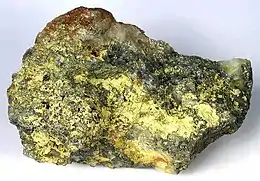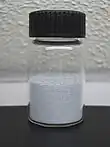Molybdenum trioxide
Molybdenum trioxide describes a family of inorganic compounds with the formula MoO3(H2O)n where n = 0, 1, 2. These compounds are produced on the largest scale of any molybdenum compound. The anhydrous oxide is a precursor to molybdenum metal, an important alloying agent. It is also an important industrial catalyst.[8] It is a yellow solid, although impure samples can appear blue or green.
| |||
| Names | |||
|---|---|---|---|
| IUPAC name
Molybdenum trioxide | |||
| Other names | |||
| Identifiers | |||
| |||
3D model (JSmol) |
|||
| ChEBI | |||
| ChemSpider | |||
| ECHA InfoCard | 100.013.823 | ||
| EC Number |
| ||
PubChem CID |
|||
| UNII | |||
| UN number | 3288 | ||
CompTox Dashboard (EPA) |
|||
| |||
| |||
| Properties | |||
| MoO3 | |||
| Molar mass | 143.95 g·mol−1 | ||
| Appearance | yellow solid | ||
| Odor | odorless | ||
| Density | 4.70 g/cm3[1] | ||
| Melting point | 802 °C (1,476 °F; 1,075 K)[1] | ||
| Boiling point | 1,155 °C (2,111 °F; 1,428 K)(sublimes)[1] | ||
| 1.066 g/L (18 °C) 4.90 g/L (28 °C) 20.55 g/L (70 °C) | |||
| Band gap | >3 eV (direct)[2] | ||
| +3.0·10−6 cm3/mol[3] | |||
| Structure[4] | |||
| Orthorhombic, oP16 | |||
| Pnma, No. 62 | |||
a = 1.402 nm, b = 0.37028 nm, c = 0.39663 nm | |||
Formula units (Z) |
4 | ||
| see text | |||
| Thermochemistry[5] | |||
Heat capacity (C) |
75.0 J K−1 mol−1 | ||
Std molar entropy (S⦵298) |
77.7 J K−1 mol−1 | ||
Std enthalpy of formation (ΔfH⦵298) |
−745.1 kJ/mol | ||
Gibbs free energy (ΔfG⦵) |
-668.0 kJ/mol | ||
| Hazards[6] | |||
| GHS labelling: | |||
  | |||
| Warning | |||
| H319, H335, H351 | |||
| P201, P202, P261, P264, P271, P280, P281, P304+P340, P305+P351+P338, P308+P313, P312, P337+P313, P403+P233, P405, P501 | |||
| NFPA 704 (fire diamond) | |||
| Flash point | Non-flammable | ||
| Lethal dose or concentration (LD, LC): | |||
LD50 (median dose) |
125 mg.kg (rat, oral) 2689 mg/kg (rat, oral)[7] | ||
LDLo (lowest published) |
120 mg Mo/kg (rat, oral) 120 mg Mo/kg (guinea pig, oral)[7] | ||
LC50 (median concentration) |
>5840 mg/m3 (rat, 4 hr)[7] | ||
| Related compounds | |||
Other cations |
Chromium trioxide Tungsten trioxide | ||
Related molybdenum oxides |
Molybdenum dioxide "Molybdenum blue" | ||
Related compounds |
Molybdic acid Sodium molybdate | ||
Except where otherwise noted, data are given for materials in their standard state (at 25 °C [77 °F], 100 kPa).
Infobox references | |||
Structure

In the gas phase, three oxygen atoms are bonded to the central molybdenum atom. In the solid state, anhydrous MoO3 is composed of layers of distorted MoO6 octahedra in an orthorhombic crystal. The octahedra share edges and form chains which are cross-linked by oxygen atoms to form layers. The octahedra have one short molybdenum-oxygen bond to a non-bridging oxygen.[9][10] Also known is a metastable (β) form of MoO3 with a WO3-like structure.[11][2]
Preparation and principal reactions
MoO3 is produced industrially by roasting the compound molybdenum disulfide, the chief ore of molybdenum:[8]
- 2 MoS2 + 7 O2 → 2 MoO3 + 4 SO2
The laboratory synthesis of the dihydrate entails acidification of aqueous solutions of sodium molybdate with perchloric acid:[12]
- Na2MoO4 + H2O + 2 HClO4 → MoO3(H2O)2 + 2 NaClO4
The dihydrate loses water readily to give the monohydrate. Both are bright yellow in color.
Molybdenum trioxide dissolves slightly in water to give "molybdic acid". In base, it dissolves to afford the molybdate anion.
Uses
Molybdenum trioxide is used to manufacture molybdenum metal:
- MoO3 + 3 H2 → Mo + 3 H2O
Molybdenum trioxide is also a component of the co-catalyst used in the industrial production of acrylonitrile by the oxidation of propene and ammonia.
Because of its layered structure and the ease of the Mo(VI)/Mo(V) coupling, MoO3 is of interest in electrochemical devices and displays. It has been described as "the most commonly used TMO in organic electronics applications ... it is evaporated at relatively low temperature (~400 °C)."[13]

References
- Haynes, p. 4.77
- Balendhran, Sivacarendran; Walia, Sumeet; Nili, Hussein; Ou, Jian Zhen; Zhuiykov, Serge; Kaner, Richard B.; Sriram, Sharath; Bhaskaran, Madhu; Kalantar-zadeh, Kourosh (2013-08-26). "Two-Dimensional Molybdenum Trioxide and Dichalcogenides". Advanced Functional Materials. 23 (32): 3952–3970. doi:10.1002/adfm.201300125. S2CID 95301280.
- Haynes, p. 4.134
- Åsbrink, S.; Kihlborg, L.; Malinowski, M. (1988). "High-pressure single-crystal X-ray diffraction studies of MoO3. I. Lattice parameters up to 7.4 GPa". J. Appl. Crystallogr. 21 (6): 960–962. doi:10.1107/S0021889888008271.
- Haynes, p. 5.15
- "Molybdenum trioxide". pubchem.ncbi.nlm.nih.gov.
- "Molybdenum (soluble compounds, as Mo)". Immediately Dangerous to Life or Health Concentrations (IDLH). National Institute for Occupational Safety and Health (NIOSH).
- Roger F. Sebenik; et al. (2005). "Molybdenum and Molybdenum Compounds". Ullmann's Encyclopedia of Industrial Chemistry. Weinheim: Wiley-VCH. doi:10.1002/14356007.a16_655.
- "Molybdite Mineral Data". Webmineral.
- Wells, A.F. (1984) Structural Inorganic Chemistry, Oxford: Clarendon Press. ISBN 0-19-855370-6.
- McCarron, E. M. (1986). "β-MoO3: A Metastable Analogue of WO3". J. Chem. Soc., Chem. Commun. (4): 336–338. doi:10.1039/C39860000336.
- Heynes, J. B. B.; Cruywagen, J. J. (1986). Yellow Molybdenum(VI) Oxide Dihydrate. Inorganic Syntheses. Vol. 24. pp. 191–2. doi:10.1002/9780470132555.ch56. ISBN 9780470132555.
- Meyer, Jens; Hamwi, Sami; Kröger, Michael; Kowalsky, Wolfgang; Riedl, Thomas; Kahn, Antoine (2012). "Transition Metal Oxides for Organic Electronics: Energetics, Device Physics and Applications". Advanced Materials. 24 (40): 5408–5427. Bibcode:2012AdM....24.5408M. doi:10.1002/adma.201201630. PMID 22945550. S2CID 197055498.
Cited sources
- Haynes, William M., ed. (2011). CRC Handbook of Chemistry and Physics (92nd ed.). CRC Press. ISBN 978-1439855119.
External links
- Greenwood, Norman N.; Earnshaw, Alan (1997). Chemistry of the Elements (2nd ed.). Butterworth-Heinemann. ISBN 978-0-08-037941-8.
- U.S. Department of Health and Human Services National Toxicology Program
- International Molybdenum Association
- Los Alamos National Laboratory – Molybdenum
-oxid_Kristallstruktur.png.webp)

